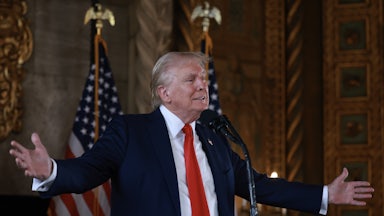I can’t recall ever seeing presidential candidates condescend to the public on the subject of the economy to anything like the degree we’ve seen this year. There are two economies right now: the real one and the make-believe version that Donald Trump and Kamala Harris both pretend is real—Trump, in order to trash the Biden-Harris record, and Harris to pacify voters who keep telling pollsters that inflation is out of control, which it isn’t.
Inflation is, in fact, so very not out of control that the Federal Reserve will almost certainly announce a cut in interest rates Wednesday for the first time in four years. Some Democrats have expressed hope that this action will persuade voters that the Covid-induced spike in the consumer price index that, to review, began with a 4.2 percent increase in April 2021, peaked at 9.1 percent in June 2022, started falling immediately thereafter, and stands now at a very civilized 2.5 percent—that this inflation surge has been over for some time. The Fed is worrying now not about inflation but about unemployment, which is still fairly low at 4.2 percent, but could become a problem as the economy cools.
I have urged Harris to say: “Wake up and smell the coffee, voters, this economy is thriving!” The argument against this, which has thus far prevailed, is that many people are still hurting. That’s unquestionably true with respect to long-term unfavorable trends like the 45-year-long runup in income inequality (about which I published a book 12 years ago). But setting aside how unsatisfactory economic conditions have remained through the past half-century, most people are better off today than they were four years ago. Indeed, if discontent expressed to pollsters about the economy were limited to those who feel worse off today than four years ago, you wouldn’t see, in a September 11–12 Financial Times-University of Michigan Ross School of Business poll, fully 72 percent of registered voters saying economic conditions in the United States are “negative” even as the proportion who report personally experiencing difficulty in meeting expenses is a much lower 26 percent.
What we have here is the familiar American habit of believing oneself better off than others, as documented in David Whitman’s 1998 book, The Optimism Gap: The I’m OK–They’re Not Syndrome and the Myth of American Decline and Gregg Easterbrook’s 2018 book, It’s Better Than It Looks: Reasons for Optimism in an Age of Fear. Paul Krugman of The New York Times has cited multiple instances lately of the I’m OK–you’re not mindset, noting, for instance, a Quinnipiac poll from May that showed a robust 65 percent rated their personal finances “excellent or good” even as only 35 percent would say the same about the economy, and an April Wall Street Journal swing-state poll showing 54 percent of voters in all seven states rated their own state’s economy “excellent or good” while only 36 percent would say the same about the national economy.
When you judge local conditions to be favorable and distant ones to be unfavorable, you’re likely to take a dim view of distant (i.e., federal) authority. The result is that both Trump and Harris are selling themselves as candidates of change. In Harris’s case, she’s selling herself mostly as a departure from the tiresome chaos of Trump’s presidency, but she’s also inviting voters to judge her a refreshing departure from the Biden administration (otherwise known as the Biden-Harris administration). In addition to lacking plausibility, this strategy obliges Harris to downplay the Biden-Harris administration’s superb record on managing the economy, which ought to have particular appeal to the working-class voters she needs to attract.
Is the strategy working? Possibly so. That same Financial Times poll showed for the second month in a row that more voters trusted Harris on the economy (44 percent) than Trump (42 percent), with Harris’s advantage expanding from one percentage point to two. That trend coincided with a growing proportion of voters disapproving of how President Joe Biden handled the economy (59 percent in May, June, July, and August; 60 percent in September). Biden truly doesn’t deserve this abuse.
Most other polls continue to give Trump the edge over Harris on the economy, but a Reuters/Ipsos poll released Sunday showed Harris had a one-point advantage over Trump (43 to 42 percent) on which candidate would create “an economic climate that is good for me and my family.” The same poll had Harris leading Trump overall by five percentage points.
What I don’t see evidence for is that Harris is winning over working-class voters, without whom I believe Harris can’t win. Biden, who was the first Democrat in a century to win the White House without a working-class majority (defined as non-college voters), had a deficit of four percentage points with this group. A Pew Research Center poll conducted August 26 to September 2 put Harris’s working-class deficit at 13 percentage points. Last week Ruy Teixeira, co-author with John Judis of Where Have All the Democrats Gone?, cited a New York Times/Siena College poll conducted September 3–6 that put Harris’s working-class deficit as 17 percentage points. Teixeira further noted that non-college voters were much more pessimistic about the economy than college voters, with 57 percent calling it “poor” (against 37 percent of college grads).
What is Trump doing to seduce America’s working class? Is he promising to revive the labor movement? Proposing higher taxes on the rich? Endorsing a higher minimum wage? Fat chance. He’s promising to cut taxes, not only for corporations and rich individuals but also for Social Security retirees, tipped workers, and now people who work overtime. You say you don’t like how the federal government manages the economy? Then I’ll reduce how much it takes out of your wages.
I’ve written previously about the fiscal recklessness of Trump’s Social Security and tipped-workers tax cuts. In the latter instance, Trump was presented with a regulatory problem: The government permits employers to pay tipped workers a scandalously low subminimum hourly wage of $2.13. The obvious solution, which Harris favors, is to pay tipped workers the same $7.25 hourly minimum as everybody else (and yes, $7.25 is too low). But Trump opposes regulations that impose additional costs on business. His solution: Redefine the regulatory problem as a taxation problem. Instead of mandating a higher minimum for tipped workers, eliminate taxes on their tips. This proposal was so popular with restaurant workers in Nevada that Harris endorsed it too.
But scratch the glittering surface and you won’t find much underneath. As Ernie Tedeschi of the Yale Budget Lab pointed out last June, tipped workers would derive little benefit from no longer paying income tax on their tips because they don’t pay much income tax (on wages plus tips) to begin with. Fully 37 percent pay no income tax at all. Raising tipped workers’ pay from $2.13 to $7.25, on the other hand, would increase, quite tangibly, tipped workers’ income.
It’s sometimes suggested that when tipped workers get paid more, their tips go down. But a 2021 study by the Center for American Progress examined states that eliminated tipped wage minimums and found no evidence that tipping was lower there than in states where tipped minimums remained in force. It’s employers, not tippers, who would likely pay less under Trump’s plan, reasoning that the IRS had already given tipped workers a “raise” in the form of a tax holiday. Employers would also likely maneuver to expand opportunities for their workers to be paid in tips rather than in wages, letting Uncle Sam take up the slack.
The same logic applies to Trump’s proposed elimination of taxes on overtime. The regulatory solution to the problem set forth by the Obama administration and, later, the Biden administration, was to expand overtime eligibility to an estimated four million additional workers. As president, Trump rejected that approach—expanding overtime coverage, yes, but only to about one million additional workers—again, to pacify business, which is always his paramount concern.
If Trump is reelected, he’ll likely scale back Biden’s overtime regulation so that the expansion covers one million rather than four million additional workers. That would lower the very high cost to the taxpayer of Trump’s tax holiday for overtime pay ($680 billion over 10 years, according to the Tax Foundation). But it would deprive three million workers of time-and-a-half pay when they work more than 40 hours in a given week. Once again, Trump’s favored solution is to shift labor costs from employer to taxpayer. (And he calls Harris a Communist!)
Exempting overtime from taxes would be more meaningful, financially, to workers than exempting tips. But both Trump proposals sidestep the real taxation problem for working-class voters, which isn’t the progressive income tax at all. Rather, it’s the notoriously regressive payroll, or “FICA,” tax.
The FICA tax is a flat 7.65 percent tax on employers and employees that funds Social Security and Medicare. Payroll taxes constitute one-third of all federal revenue, leaving most Americans paying more—in many cases, a lot more—in payroll tax than in income tax. Among people earning anywhere from $10,000 to $100,000, more than 70 percent pay more in payroll tax than in income tax. Up to $200,000, a clear majority pay more in payroll tax than in income tax, according to data assembled by the nonprofit Tax Foundation. That explains why Americans report feeling over-taxed when, historically, income taxes fall much less heavily on just about everybody. They’re talking about the FICA tax.
Above incomes of $200,000, the proportion of payroll tax to income tax falls precipitously. Partly that’s because these taxpayers are now rising into higher marginal income tax brackets: 24 percent, 32 percent, 35 percent, and 37 percent. But it’s mainly because income above $168,600 escapes the Social Security portion of the FICA tax (i.e., most of it) entirely. The FICA tax is therefore regressive in two ways: It’s a flat tax, and it exempts high incomes. (The Medicare portion, which accounts for only 1.45 percent of the 7.65 percent, has no income cap, and at very high incomes an additional tax on net investment kicks in, so it’s more progressive.)
Because Social Security and Medicare are both projected to go bust a decade from now, sometime soon Congress will have to increase the FICA tax, and the only reasonable way to do that will be to make it more progressive. The fairest way to do that is to reduce it below 7.65 percent at the low end, eliminate the Social Security cap entirely, and raise the FICA tax well above 7.65 percent at the high end. That would make a much bigger difference for the working class than anything Trump’s talking about. But Trump won’t support it, and Harris won’t likely talk about the payroll tax at all during this campaign because Social Security is the third rail of American politics.
Still, as recently as 2019, Harris was one of four senators to co-sponsor, with Senator Bernie Sanders, the Social Security Expansion Act, which, among other things, would eliminate the cap on Social Security taxes. That’s a start, anyway. Pass it on.











